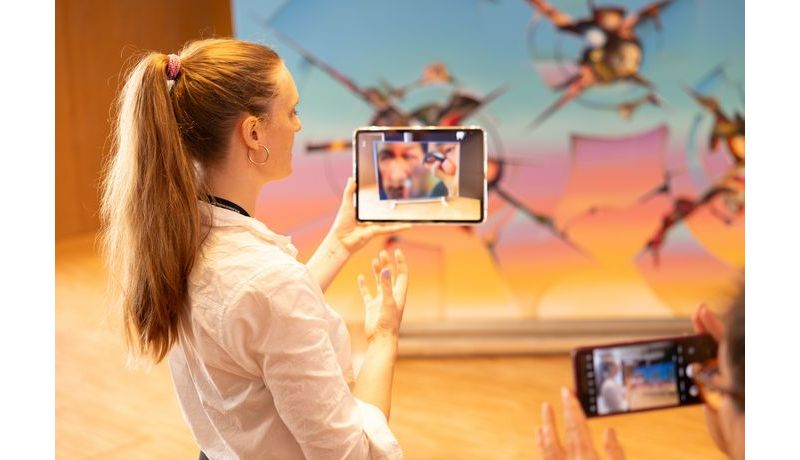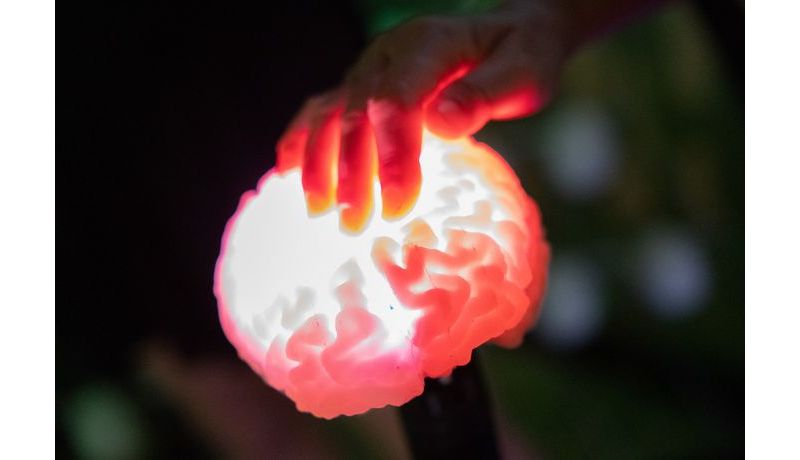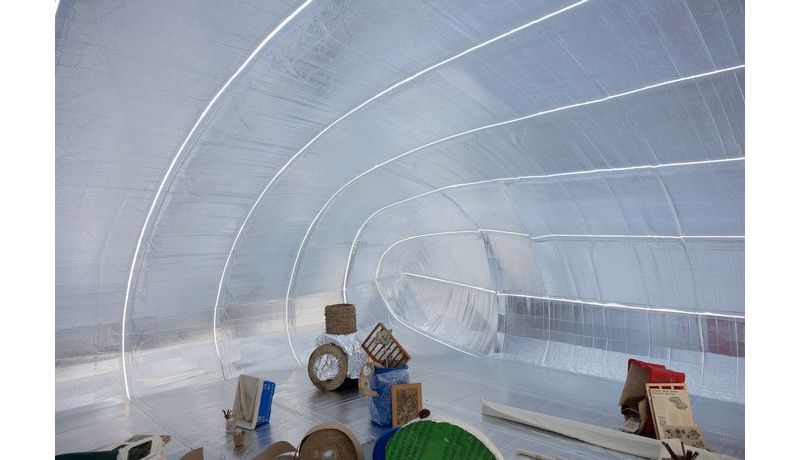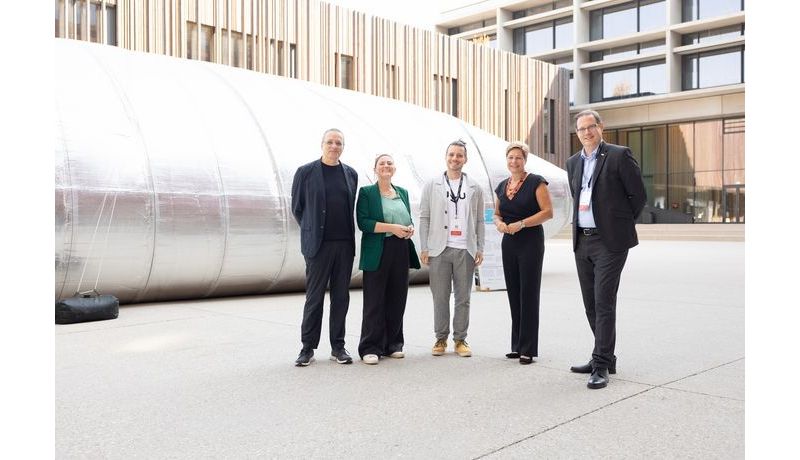The JKU MED Campus will debut as one of this year's active venues during the 2024 Ars Electronica Festival.

For the first time, the JKU Medical Campus is one of this year's Ars Electronica Festival venues, coinciding with the JKU Faculty of Medicine’s 10th anniversary. Located in the heart of Linz, the JKU will welcome visitors free of charge and showcase innovative installations at the crossroads of art and science. In keeping with the Festival’s theme of “HOPE - Who Will Turn the Tide”, the JKU invites visitors to actively engage, ask questions, reflect, hold discussions, and be inspired.
What does the inside of the human body look like? What are some of the human stories hidden behind digital platforms? What does AI-generated music sound like? And how do gut bacteria affect our emotions?
During this year's Ars Electronica Festival, all this and more will become tangible, audible, and on display in the form of ten JKU Art & Science installations sponsored by the Linz Institute of Technology (LIT) and others, all free of charge and publicly accessible at the JKU MED Campus, POSTCITY (first floor), and at St. Mary’s Cathedral (Mariendom) in Linz.
JKU Rector Stefan Koch is very enthusiastic: “Regardless of whether we are addressing climate change, inflation, or artificial intelligence, we need new ideas and creativity to ensure a more sustainable future. Science and art can potentially serve as a catalyst to drive innovative ideas forward. In this spirit, I am extremely delighted that once again during this year's Ars Electronica Festival – and for the first time at the JKU MED Campus in the city center of Linz - JKU researchers will provide unique insight into their cross-disciplinary research.”
Opened in 2021, the JKU MED Campus will now debut as a Festival venue, showcasing a diverse program of events and activities that invite visitors to explore the campus. Starting at the Piazza to experience the “Spaceship from Hope” installation, to the Laboratory Building, the JKU medSPACE, the Education Building, home to the Ars Electronica exhibition “Applied Virtualities: Extended Reality in Practice”, and the Medical Library, visitors can experience interactive Art & Science projects, installations, and exhibitions throughout the MED Campus.
Elgin Drda, JKU Vice-Rector of Medicine, is delighted that the JKU MED Campus will be one of the Festival venues: “The JKU MED Campus serves as a vibrant community hub for our medical students, researchers, and faculty members This makes inviting everyone in Linz to come and visit our campus during the Ars Electronica Festival even more special, particularly to mark the JKU Faculty of Medicine’s 10th anniversary. Visitors can expect exciting insight into our cutting-edge medical research and innovative educational courses, including our globally unique JKU medSPACE. Come and experience for yourself just how university medicine meets art, right here in the heart of Linz!”
Gerfried Stocker, Artistic Director at the Ars Electronica, adds: “Despite a trend toward collaboration in art and science – something we certainly hear about when listening to opening speeches or when reading strategic papers - in reality, it is a little more complicated. This is why I am particularly pleased about the close partnership between Ars Electronica and the Johannes Kepler University Linz! It is extremely important because when art and science come together, the ideas support new practices and processes, leaving thought patterns behind and exploring how we can look at things in a completely different way and move forward together. As the world continues to change rapidly, the key to success is a willingness and ability to work together in a respectful and effective spirit. Everyone at the JKU MED Campus will be able to experience this spirit first-hand!”
A Quantum Concerto World Premiere in St. Mary's Cathedral
And just what would a composition by composer Anton Bruckner actually sound like as a quantum concerto? During the Ars Electronica Festival opening in the St. Mary’s Cathedral in Linz on Wednesday, September 4, visitors can experience a unique world premiere as Anton Bruckner's music will be performed in a completely new way, augmented by quantum mechanics. Two of the cathedral’s organists will play two of the cathedral’s echoing church organs live, filling the spectacular acoustic space in St. Mary's Cathedral with sound. During a performance to mark Anton Bruckner's 200th birthday, entangled photon pairs made from lasers will take on the role of a conductor, demonstrating the incredible findings behind the second quantum revolution. The performance has been made possible by a partnership between the JKU Institute of Integrated Circuits, the Vienna University of Technology, the University of Innsbruck, the University of Art and Design Linz, and international artists celebrating Bruckner's 200th birthday.
See: https://www.jku.at/en/ars-electronica-2024-hope-who-will-turn-the-tide/ to learn more about the 2024 Ars Electronica Festival.
Photos (free of charge), photo credit: Tom Mesic
· Photo 1: Ars Electronica Artistic Director Gerfried Stocker, head of Ars Electronica Festival Christl Baur, JKU Ars Electronica coordinator Gregor Pechmann, JKU VR Elgin Drda and JKU Rector Stefan Koch in front of “Spaceship from Hope”, f.l.t.r, photo credit: Tom Mesic
· Photo 2: “Hack the Hat”, photo credit: Tom Mesic
· Photo 3: “Neural Neighborhood”, photo credit: Tom Mesic
· Photo 4: “Spaceship from Hope” (inside), photo credit: Tom Mesic
JKU Art & Science Installations at the 2024 Ars Electronica Festival:
JKU MED Campus
Hack the Hat
This interactive game takes a critical look at AI-controlled recruitment. Merlin Kepler, a magic school graduate, must pass the magical sorting hat test. Having already been rejected several times, he must now modify his CV to discover how changing his gender, age, experience, or skills will affect the AI's decisions. The goal is to help Merlin get through the selection process and expose the AI's hidden biases and discriminatory criteria.
Created by: the JKU Institute for Computational Perception
Project manager: Anna Hausberger
3D Live Anatomy Preview
Understanding human anatomy is the basis to conducting medical research and educating future physicians and healthcare professionals. The JKU medSPACE at the MED Campus has been providing fascinating insight into the human body since 2021. Developed by the Ars Electronica Futurelab in collaboration with Siemens Healthineers and the JKU, the “Cinematic Anatomy x Deep Space” software facilitates 3D, high-resolution visualizations of human anatomical structures. New data sets provided by the European Synchrotron Radiation Facility are boosting innovation even further. Now, for the first time, scientists can zoom in on the microscopic interior of an organ - such as the brain - revealing never-before-seen details, structures, fibers, and connective tissue.
The active partnership between the JKU and the Medical University of Graz means medical students studying in Graz will also have the opportunity to experience the JKU medSPACE and watch live, 3D presentations conducted by Prof. Fellner in Linz. The server in Graz is controlled via the Internet. Prof. Hammer can demonstrate specimens in the anatomy room in Graz, thereby blending conventional anatomical instruction and virtual anatomical instruction.
Created by: JKU Institute for Virtual Morphology
Project manager: Franz Fellner
Microbial Mindscapes
The human microbiome generates neurotransmitters and this multi-sensory installation explores just how the human gut microbiome and brain can affect and impact one's emotional state. Using AI, the artist's microbiome is transformed into an audiovisual experience. The installation aims to not only open the door to conversation and debate on just how AI can understand complex human emotions, but also challenge traditional concepts toward life, intelligence and how human life interacts with microbial species.
Created by: the JKU Institute for Biophysics
Project manager: Yoojin Oh
Neural Neighborhood
Small, transparent brain casts fitted with RGB LED lights make up this unique installation influenced by adjacent brain casts, creating a luminescent and complex pattern of light. When a visitor interacts with the installation, it triggers new “cells”, generating a dazzling, vibrant pattern. The installation comes to life by means of both tactile and contactless interaction, illustrating not only how simple interactions can result in complexities, but also mirroring just how interconnected societies, ecosystems, and the brain are. Small acts can have a huge impact.
Created by: the JKU Institute of Polymer Product Engineering
Project manager: Martin Reiter
On the (Side)line
This interactive installation that takes a look behind the shiny façade of digital platforms, including Facebook and Amazon. Despite appearing user-centric and innovative, they rely heavily on manual labor by often unseen people located in the global south to generate content and train the AI. Their job responsibilities affect our online experience and yet they are often neither appreciated nor paid for their labor. Using augmented reality, this installation shines a light on often overlooked individuals and their workplace realities.
Created by: the Linz Institute for Transformative Change
Project manager: Thomas Gegenhuber
Raise Your Voice
In a world where adults tend to not listen to what children have to say, an interactive art installation, Raise Your Voice, takes a tongue-in-cheek look at the age authority gap by transforming children’s and young people’s voices into adult voices, giving the audience an opportunity to consider how they experience, perceive, and hear what is being said.
Created by: the Institute for Computational Perception
Project manager: Jan Schlüter
Touching Thoughts
The Touching Thoughts installation at the JKU medSPACE takes visitors on a journey into the microscopic world of the brain’s neural networks and inside cancer cells. Digitally reconstructed tissue samples rendered by artists have been transformed into impressive 3D data sets, demonstrating how art and technology can impact scientific discoveries and medical education.
Created by: the JKU Institute for Anatomy and Cell Biology
Project manager: Sabina Köfler
St. Mary's Cathedral (Mariendom)
BruQner – The Sound of Entanglement
Experience the world's first quantum music concert: Musical compositions by Austrian composer Anton Bruckner are highly acclaimed far beyond Austria's borders. Austria is also internationally renowned for contributions in quantum physics – in no small part thanks winning a Nobel Prize in Physics in 2022. BruQner applies quantum mechanics to bring these two worlds together, making striking passages from Bruckner's work audible in a new way. The result is a compelling, highly engaging fusion of music, visual effects, and modern research.
Created by: the JKU Institute for Integrated Circuits
Project manager: Johannes Köfler
Ars Electronica Center Deep Space
Songs About AI
Raising the public’s awareness about AI is a crucial step toward encouraging more widespread participation and actively shaping our AI-driven future world. The “Songs About AI” installation demonstrates just how music – be it a melodic song, a rap song, dance moves, or another type of music - can promote a better understanding of AI and not only share insight into what artificial intelligence is about, but also encourage discussion and critical debate.
Created by: the JKU LIT Robopsychology Lab
Project manager: Martina Mara
POSTCITY, Ground Floor
The Turing Game
Can machines actually think? The launch of ChatGPT and other large-scale language models are sparking new and controversial debates, bringing us back to Alan Turing's decades-old question and his famous Turing Test. The Turing Game pits two people against a machine and the individuals must work together in order to identify the AI bot.
Created by: the JKU Institute for Machine Learning
Project manager: Bernhard Nessler
Additional Art & Science Installations at the JKU MED Campus:
Spaceship from Hope
Objects from Outer Space Can Turn the Tide
Spaceship from Hope explores the question of how co-existence can help ensure the future of human and non-human life on Earth. This multidisciplinary exhibition challenges the capitalist narrative of growth and advocates instead for “degrowth” and compassionate co-existence. The exhibition features five projects: The Radiotrophic Sanctuary focuses on radiotrophic fungi capable of protecting humans against radiation. The Marine Research Vessel showcases self-sufficient marine stations and using renewable energy to promote coral reef growth and biodiversity. Symbiocene explores how interspecies interact, while Toasted Furniture transforms recycled plastic into durable and sustainable furniture. As part of the Krater Feral Future Fortune Forecast, the Krater Collective addresses urban habitats and vulnerable communities.
Credits
Marko Vivoda, Saša Spačal, Luka Murovec, Nina Mršnik, Andrej Koruza, Gaja Meznaric Osole, Danica Sretenovic
The BOX 2.0
"The BOX 2.0 Will See You Now": An Interactive Artwork Exploring the Use of AI in Medical Diagnostics
Fiona Smith (GB)
THE BOX 2.0 is an interactive installation that explores the ethical and operational challenges of using AI in healthcare. Visitors can experience first-hand just how AI processes medical data, which raises questions regarding data bias and AI's transparency during the decision-making process. The exhibition invites visitors to take on the role of a patient and have their hands scanned. By means of a dynamic screen “THE BOX 2.0” will display information regarding recommended treatment. As an artist, scientist, and physician, Fiona Smith not only underscores just how important high-quality, representative data is, she also aims to raise the public’s critical awareness about using AI in medicine while simultaneously creating an engaging visitor experience.
Credits
The project was made possible with the generous help of Bianka Hofmann, Miriam Walsh, Mark Kobine, Peter Bentley, Malcolm Cruickshank, Paul Charlton, Hans Meine, Matthias Günther, Rieke Alpers, Anna Rörich, Valentin Kraft, Susanne Diekmann, Roxanne Wong and Nicola Osborne.
Transient – Cloud Chamber Vol. 1
Yuri Tanaka (JP), Akitaka Ariga (JP), Chris Bruckmayr (AT), Pavle Dinulović (RS), Umut Kose (TR), Rohan Sachdeva (IN)
Climate Organ
Chris Bruckmayr (AT), Klaus Dieterstorfer (AT), Stefan Mittlböck-Jungwirth-Fohringer (AT), Rupert Huber (AT)
Whispering Gardens
Uwe Rieger (GER), Yinan Liu (NZ), Hua Yang (CN)
Share-ploring Spatial Audio
Mauricio Valdés San Emeterio (MX)
Applied Virtualities: Extended Reality in Practice
A Realities in Transition Exhibition
In addition to the Art & Science exhibition, an installation titled “Applied Virtualities: Extended Reality in Practice” will be on display at the JKU MED Campus, focusing on innovative extended reality (XR) applications, prototypes, and research projects that are pushing the boundaries of traditional XR experiences and facilitating new creative processes.
Thierry Loa (CA) takes us on an immersive VR journey through the People's Republic of China: 21-22 CHINA features real photographs depicting how rapid urbanization and ruthless industrial development have been impacting the landscape. His second work, 21-22 USA, invites visitors to experience the vast expanses of the USA, across iconic mega-cities, highways, and desolate landscapes bearing witness to the climate catastrophe. #ALPHALOOP by Adelin Schweitzer (FR) takes participants on a 50-minute campus tour that integrates a 360° cinema experience with a live, interactive performance. You can also discover Alison's Room: XR artist Paula Strunden has created an immersive experience featuring historical design analysis, making it possible to once again walk through architect and author Alison Smithson’s (†1993) work space.
In all, there will be eight XR works on display - including:
FOHRAMOOS
Stefan Kainbacher (AT), Robert Lang (AT), Isabel Jäger-Nemec (AT) Stefhani De Albuquerque Besnyi (BR), Niklas Kübler (AT), Benedikt Hermle (GER), Daniel Malin (AT)
FIGHT BACK
Céline Tricart (FR/US), Maëlle Holtzer (FR), Julie Roué (FR)
Expectations
Staatstheater Augsburg (GER)
Department of Interfaced Dimensions
Annika Boll (GER), Eirini Lampiri (GR), Gökay Atabek (TR), Lam Lai (HK), Merve Sahin (TR), Mihai Gui (RO), Silvana Callegari (CO)
This exhibition is presented as part of the Realities in Transition project. Realities in Transition is co-funded by the European Union’s Creative Europe Programme.
See: https://ars.electronica.art/hope/en/, opens an external URL in a new window to learn more about the Ars Electronica Festival.
 Go to JKU Homepage
Go to JKU Homepage















